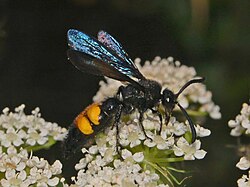| Scolia hirta | |
|---|---|
 | |
| Male | |
 | |
| Female | |
| Scientific classification | |
| Domain: | Eukaryota |
| Kingdom: | Animalia |
| Phylum: | Arthropoda |
| Class: | Insecta |
| Order: | Hymenoptera |
| Family: | Scoliidae |
| Genus: | Scolia |
| Species: | S. hirta |
| Binomial name | |
| Scolia hirta (Schrank, 1781) | |
| Synonyms [1] | |
| |
Scolia hirta is a species of wasp in the subfamily Scoliinae of the family Scoliidae.

